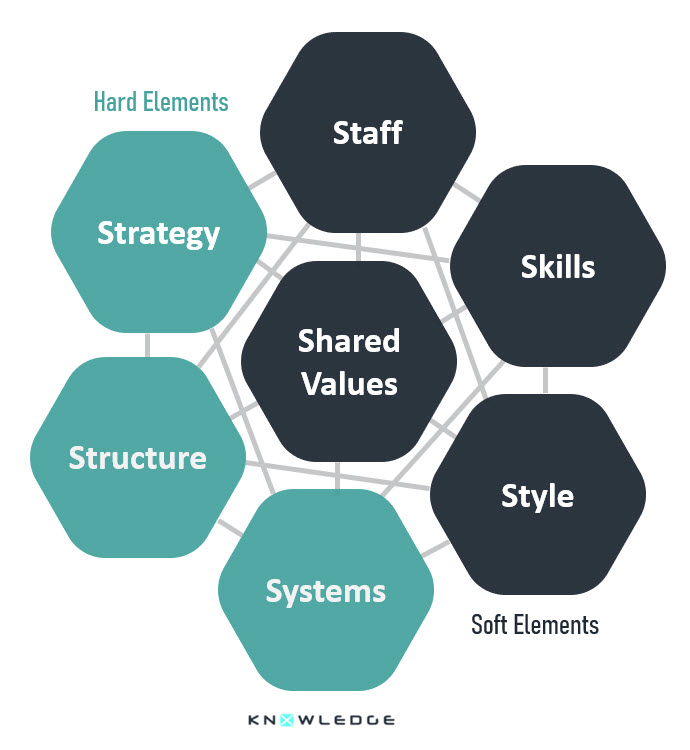Published by: Tamer Elogueil
In the pursuit of organisational excellence, understanding the intricacies of internal dynamics is paramount. Introduced in the 1980s by McKinsey consultants Tom Peters, Robert Waterman Jr., and Julien Philips, in collaboration with Richard Pascale and Anthony Athos, the McKinsey 7S Framework remains a cornerstone in management literature. Popularised in their seminal work "In Search of Excellence," this framework provides a holistic view of organisational dynamics by examining seven internal elements. These elements interact synergistically, shaping an organisation's ability to adapt, evolve, and achieve its objectives.
Usages and Application
Analysis and Diagnosis: Organisations wield the 7S Framework as a diagnostic tool, peering into their current state to discern avenues for improvement and excellence. By scrutinising each element, organisations uncover strengths, weaknesses, and areas ripe for refinement.
Alignment: Central to organisational success is the alignment of internal elements—strategy, structure, values, style, staff, systems, and skills. Leaders must synchronise these components to foster consistency and optimise performance. A change in strategy necessitates corresponding adjustments in structure, systems, and skill sets.
Change Initiatives: Implementing organisational changes, whether mergers, restructuring, or cultural shifts, demands foresight and meticulous planning. The 7S Framework aids leaders in anticipating challenges and orchestrating interventions by elucidating the interrelationships among organisational elements.
Performance Improvement: By optimising the seven elements, organisations bolster overall performance and fortify adaptability, enabling them to thrive in dynamic environments.

The 7S Framework delineates seven factors, categorised as "hard" or "soft" elements, each wielding a distinct influence on organisational dynamics.
Hard Elements:
Strategy: The bedrock of organisational endeavours, strategy delineates the roadmap for goal attainment and competitive positioning. An effective strategy articulates a compelling vision, mission, and values, furnishing a blueprint for sustained success.
Structure: This encompasses the organisational hierarchy, delineating reporting lines, roles, and responsibilities. An effective structure streamlines operations, facilitating seamless coordination and communication.
Systems: At the operational core lie systems encompassing day-to-day activities, processes, and tools. These systems underpin organisational workflows, dictating how business is conducted and efficiency achieved.
Soft Elements:
Shared Values: Anchoring organisational culture are shared values and beliefs. These superordinate goals define the ethos guiding employee behaviour and organisational actions, serving as the linchpin of organisational identity.
Style: Leadership styles permeate organisational dynamics, influencing decision-making processes and communication channels. Effective leadership entails cascading actions, fostering collaboration, and embodying organisational values.
Staff: Central to organisational vitality are its people. Effective talent management entails aligning workforce demographics, skills, and competencies with organisational objectives, nurturing employee engagement and development.
Skills: The currency of organisational prowess, skills and competencies underpin workforce effectiveness. Identifying and nurturing requisite skills equips organisations to navigate evolving landscapes with agility and acumen.
Application and Advantages
The versatility of the McKinsey 7S Framework renders it applicable across diverse sectors and organisational sizes. While it finds utility across the spectrum, its efficacy shines particularly in medium to large enterprises.
An inherent advantage lies in the framework's simplicity and self-explanatory nature. Dividing elements into hard and soft categories elucidates distinct management approaches, streamlining organisational analysis and intervention strategies.
In essence, the McKinsey 7S Framework serves as a beacon guiding organisations toward excellence. By comprehensively assessing internal dynamics and fostering alignment, organisations embark on a transformative journey, fortified to navigate the complexities of a dynamic business landscape.



Comments
No Comments added, be the first...